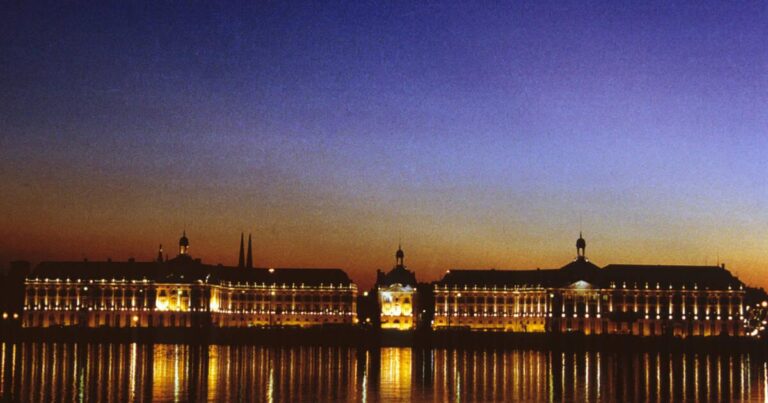Bordeaux: The Port of the Moon Unveiled
Nestled along the Garonne River, the city of Bordeaux has long been celebrated for its rich wine heritage and historical significance. Yet, there exists another layer to this vibrant urban tapestry: its nickname, the “Port of the Moon.” This moniker, which evokes intrigue, stems from the unique crescent shape of the cityŌĆÖs waterfront. As one of France’s most important ports and a UNESCO World Heritage site, BordeauxŌĆÖs distinct geographical and architectural features have played a crucial role in shaping its identity. In this article, we explore the historical, cultural, and economic factors that have contributed to Bordeaux’s endearing title, shedding light on a city steeped in tradition and modernity. Join us as we delve into the reasons behind the moniker and discover what makes Bordeaux a gem along the banks of the Garonne.
Understanding the Historical Significance of Bordeaux’s Maritime Trade
The historical significance of BordeauxŌĆÖs maritime trade can be traced back to its strategic location along the Garonne River, which flows into the Atlantic Ocean. This prime positioning transformed Bordeaux into a vibrant hub for commerce and cultural exchange from the Medieval period onward. The cityŌĆÖs port became a pivotal point for the export of wine, salt, and textiles, connecting France to crucial markets in Europe and beyond. Over centuries, Bordeaux established strong trading relations with territories in England, Spain, and even the Americas, fostering a cosmopolitan atmosphere that attracted merchants and artisans alike.
During the 18th century, Bordeaux flourished as one of France’s leading ports, particularly noted for its role in the triangle trade. The city’s maritime activities profoundly impacted both local and global economies, leading to the growth of the vineyard industry and the establishment of wine commerce networks. As maritime trade developed, so too did the cityŌĆÖs infrastructures, such as docks and warehouses, which facilitated an ongoing influx of goods and cultural influences. This era marked a golden age for Bordeaux, where the iconic architecture now lining the riverbanks tells tales of prosperity, resilience, and a legacy as a center for international trade.
The Geographical Features that Earned Bordeaux its Lunar Nickname
BordeauxŌĆÖs moniker as the “port of the moon” is intricately linked to its distinctive geographical features, particularly its unique river landscape. The Garonne River, meandering through the city, creates a stunning reflection of the night sky, reminiscent of a glowing moonlit path. This natural phenomenon is accentuated by the estuary of the Gironde, where the river meets the Atlantic Ocean, and where the tides play a crucial role in shaping the cityŌĆÖs identity. The interplay of water and light here gives visitors and residents alike a picturesque view that captures the imaginations of many.
Beyond its stunning waterways, Bordeaux’s surrounding vineyards and hillsides contribute to its celestial reputation. The region’s topography consists of gently rolling hills, which not only make for breathtaking vistas but also create a microclimate ideal for wine production. The character of the landscape leads to an interplay of sunlight, humidity, and terroir, fostering one of the worldŌĆÖs most revered wine-growing regions. As such, the geographical features of Bordeaux not only define its aesthetic appeal but also influence its cultural and economic significance, earning it a place in the annals of history as a city kissed by the moon.
Exploring the Cultural and Economic Impact of the Port
Bordeaux’s designation as the ŌĆ£port of the moonŌĆØ is not merely poetic; it reflects its profound influence on both cultural and economic realms. The port, whose unique crescent shape hugs the Gironde estuary, has historically facilitated trade, attracting merchants from around the globe. This significant maritime connection has shaped the cityŌĆÖs identity, leading to a blend of cultures that is still evident today. With its thriving wine industry, BordeauxŌĆÖs port naturally became a focal point for the export of fine wines, influencing global markets and establishing the region as a cornerstone of viticulture.
The economic implications extend beyond just trade; they resonate deeply within the local community. The port provides employment opportunities and stimulates various sectors including tourism, hospitality, and gastronomy. Consider the following impacts:
- Increased tourism: The allure of BordeauxŌĆÖs rich maritime history attracts countless visitors annually.
- Job creation: The port generates thousands of jobs, from logistics to culinary arts.
- Cultural exchange: The influx of international visitors fosters a diverse cultural landscape, evident in local festivals and events.
Moreover, the port has catalyzed infrastructural development. Recent investments in upgrading the port facilities and enhancing connectivity have bolstered the cityŌĆÖs competitiveness on the global stage. The following table summarizes key economic contributions:
| Contribution | Impact |
|---|---|
| Annual Trade Volume | Over Ōé¼1 billion |
| Tourism Revenue | Ōé¼300 million |
| Job Opportunities | Approx. 10,000 |
Recommendations for Visiting Bordeaux’s Iconic Waterfront Attractions
Bordeaux’s waterfront is a mesmerizing confluence of history and modernity, making it a must-visit for every traveler. Here, you can stroll along the Quais de Bordeaux, where the scenic views of the Garonne River and the city’s stunning architecture create an enchanting backdrop. Be sure to explore the Place de la Bourse and its iconic water mirror, known as the mirroir d’eau, which reflects the ornate 18th-century buildings, creating a captivating optical illusion. A visit in the evening offers a magical ambiance as the city is beautifully illuminated.
To truly bask in Bordeaux’s rich maritime heritage, consider these highlights:
- Cap Science: A contemporary science center with exhibitions on marine science and aquarium life.
- Cit├® du Vin: An immersive wine museum that celebrates Bordeaux’s famed viticulture.
- Les Bassins de Lumi├©res: A unique digital art center located in a former submarine base, showing breathtaking exhibitions.
| Attraction | Location | Highlights |
|---|---|---|
| Cap Science | Quai de Bacalan | Interactive marine exhibits |
| Cit├® du Vin | Chartrons District | Tasting sessions and workshops |
| Les Bassins de Lumi├©res | Jardin de lŌĆÖIntendance | Cycle of immersive digital art |
Final Thoughts
In conclusion, Bordeaux’s designation as the “Port of the Moon” is a testament to its unique geographic and cultural heritage. The city, with its crescent-shaped riverfront, has long served as a pivotal hub of trade and maritime activity. This nickname not only reflects its topographical charm but also encapsulates the historical significance and vibrant spirit that continue to define Bordeaux today. As the city evolves, embracing both its rich past and promising future, the legacy of its moonlit port will undoubtedly continue to illuminate its status on the world stage.




